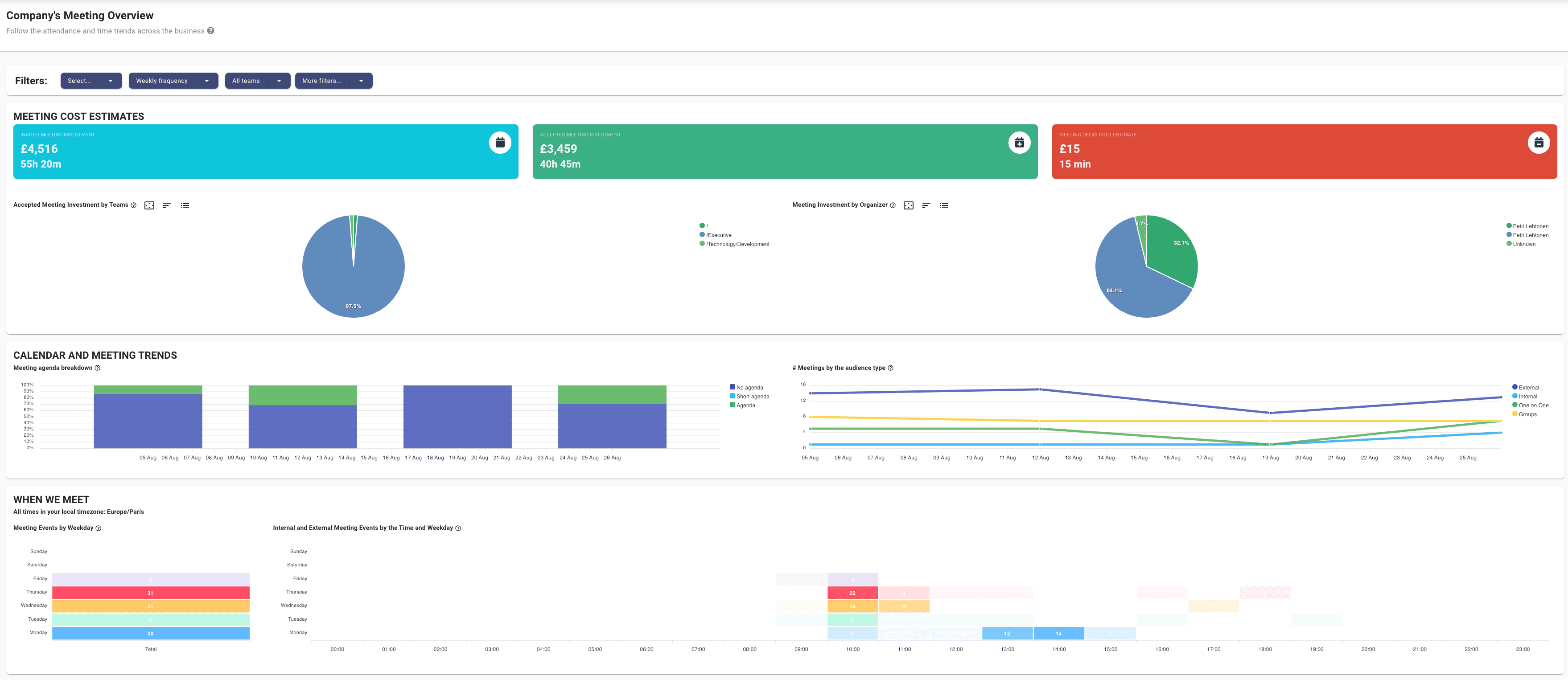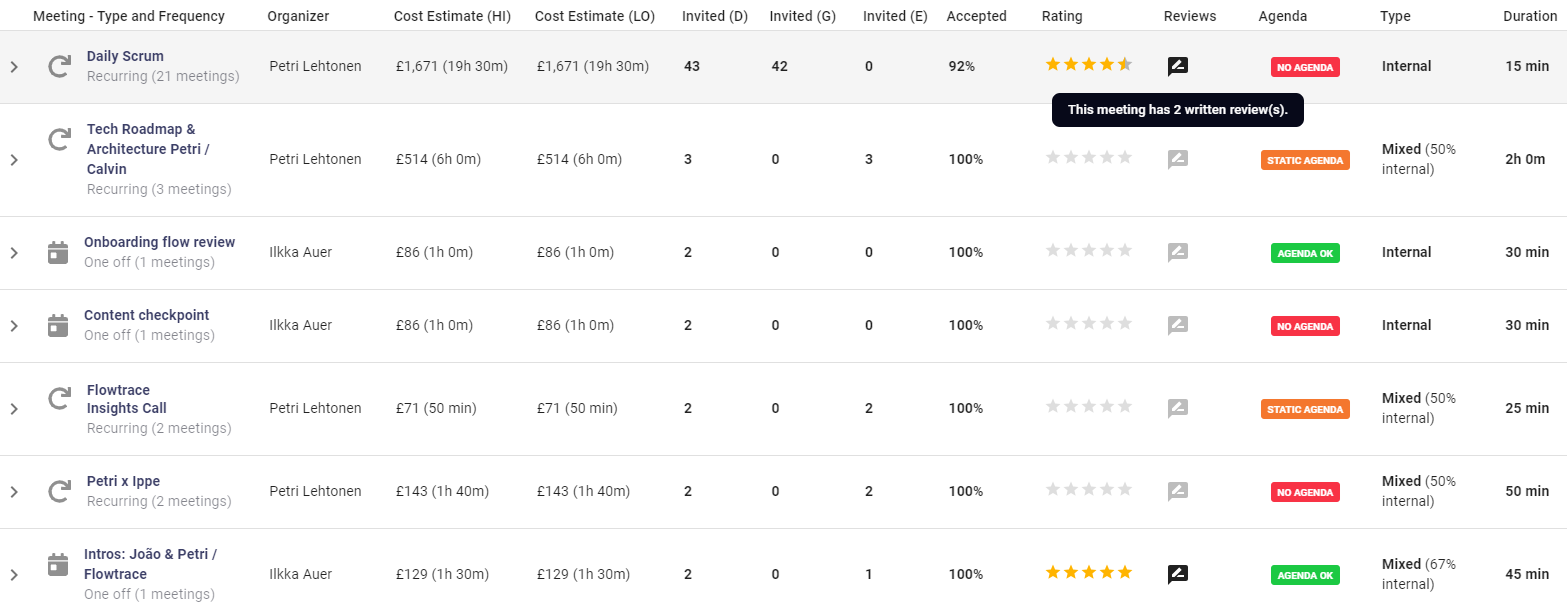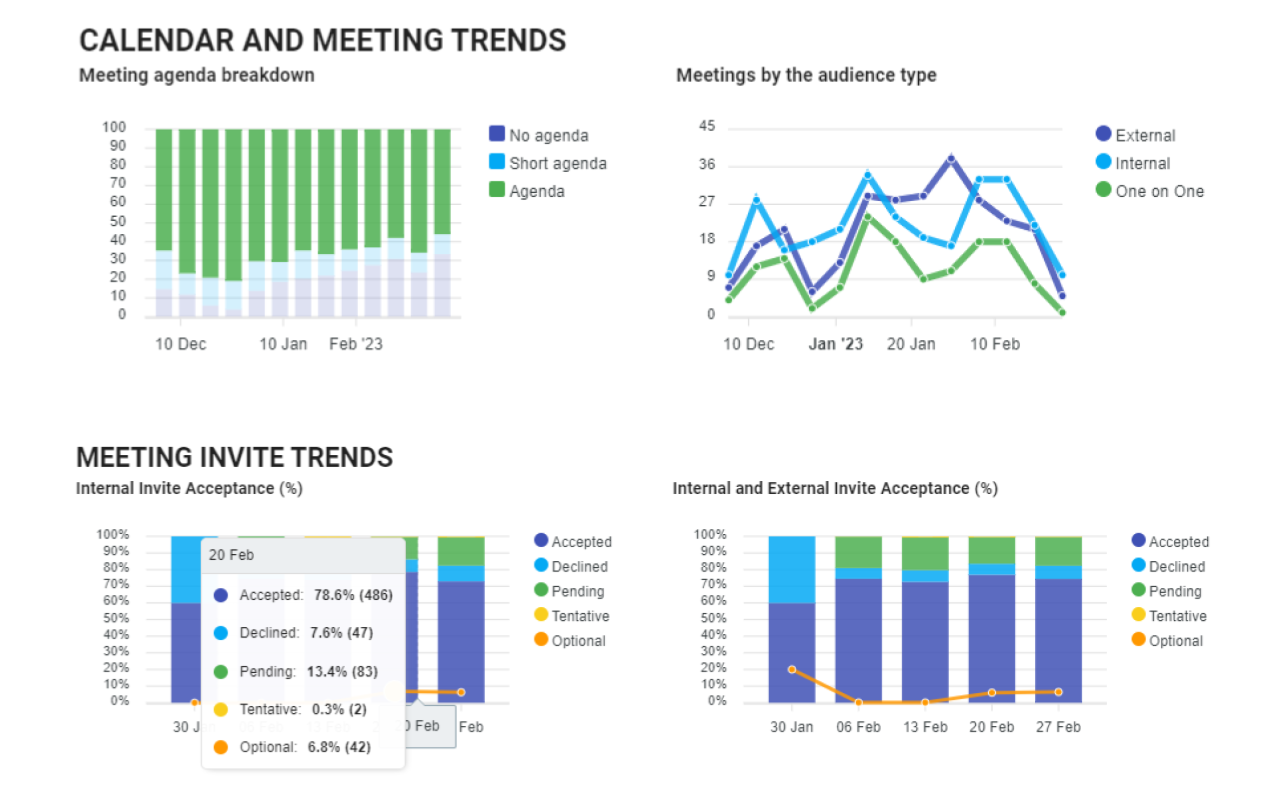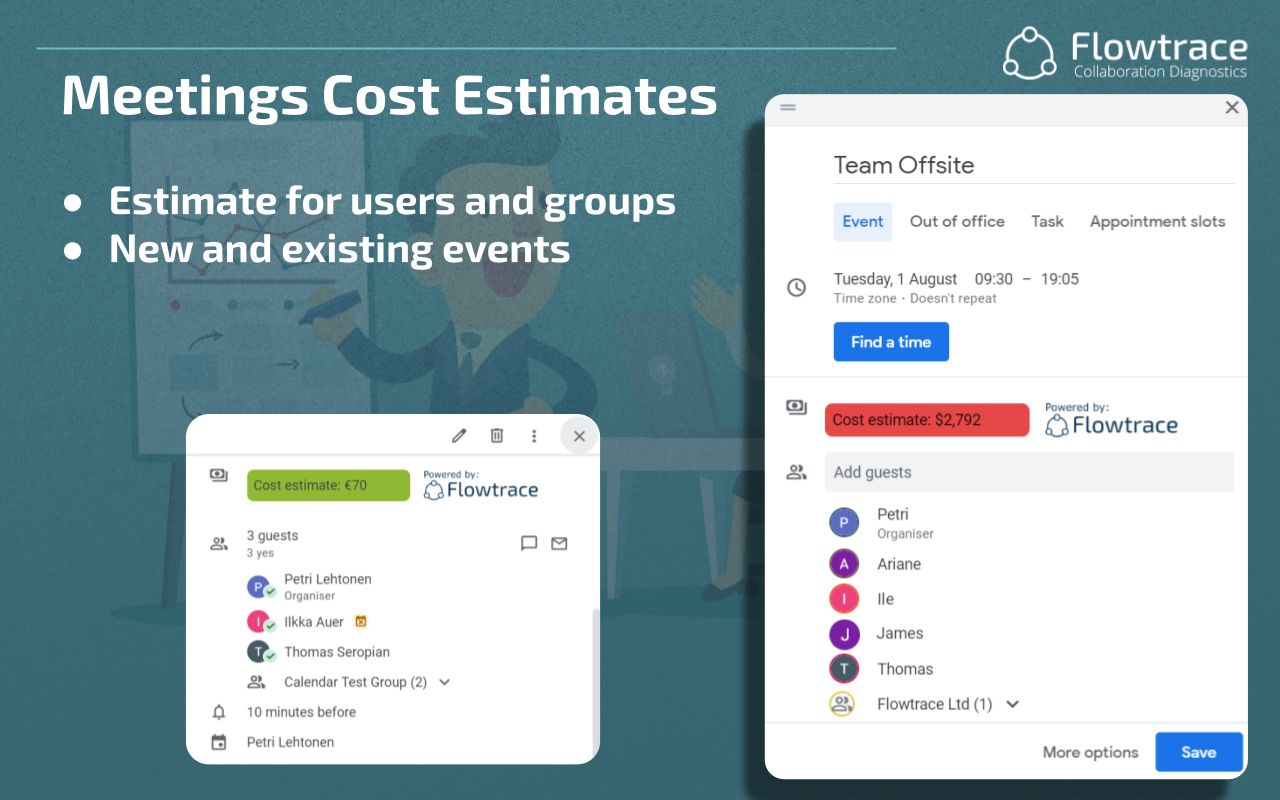How to Reduce Meeting Fatigue
Combat meeting fatigue with a data-driven system that optimizes schedules, enforces agendas, and promotes focused work for fewer, more effective...
Discover solutions to common meeting challenges, from reducing unnecessary sessions to enhancing productivity, with practical insights and tools for better team collaboration.
Meetings are meant to move work forward, but too often, they do the opposite. Bloated calendars, unclear agendas, recurring sessions with no clear outcomes… these aren’t just annoyances. They’re signals of deeper problems in how teams collaborate.
If you’ve ever wondered, “Do we really need this meeting?” or “Why does my entire day disappear into Zoom calls?”, you’re not alone. In this guide, we answer the most common questions about meeting challenges and, more importantly, show how teams can fix them.
Whether you're in ops, HR, or team leadership, this Q&A format will help you diagnose the real issues behind meeting overload and give you a framework for solving them.
When we look at meetings organization-wide, a few recurring issues consistently emerge:
These symptoms point to cultural and systemic breakdowns, inefficient planning, lack of governance, and unclear accountability. The result? Teams lose time, clarity evaporates, and unnecessary stress builds.
Smart tools that surface trends, like agenda usage analytics and invite-count tracking, help root out these problems. Flowtrace, for instance, ties meeting metadata to calendars to identify where expectations drift and meeting culture starts to fail.
We end up with an overwhelming number of meetings each week because organizations default to reactive scheduling and lack clear communication norms, so every decision, update, or check-in triggers a new calendar invite. In the absence of robust asynchronous processes (like shared documents or status boards), teams rely on live meetings to fill information gaps.
Without centralized visibility, leaders can't spot spikes in recurring sessions, cross-team overlap, or identify if meetings are being used as a default response instead of a purposeful tool. This creates a self-perpetuating cycle of overloaded calendars.

By using calendar dashboards that map meeting volume and recurrence, broken down by team and individual, ops can proactively identify where “meeting fatigue” begins. Implementing recurring-meeting justification nudges keeps calendars healthier over time.
To determine meeting productivity, measure whether each session achieves its objectives: they should start and end on schedule, follow a clear agenda, document decisions, and assign actionable next steps. By evaluating these key criteria, you establish a reliable framework that distinguishes high-value meetings from time drains.
Metrics like agenda presence, punctuality, and attendance consistency matter most. Additionally, tracking whether meetings lead to action (versus wandering conversations) reveals true value.
Once teams commit to capturing agendas and aligning outcomes, you can surface patterns of wasted time. Feature sets that include agenda validation and follow-up tracking are invaluable here. Flowtrace monitors agenda compliance and flags meetings that run overtime or lack clear purpose, helping teams improve systematically.
Back-to-back meetings are often the result of calendar fragmentation, where insufficient buffer time between sessions prevents meaningful preparation and transition. This pattern typically reflects a lack of intentional scheduling policies; teams book follow-ups reactively instead of planning with purpose, leading to constant context switching and reduced productivity.
When your calendar is packed with sequential sessions, it's not necessarily overbooking; it might be a sign of a broader organizational issue. Calendar fragmentation isn't just frustrating, it has a real cost. According to a 2023 study, knowledge workers only experience around 2 hours 48 minutes of “productive time” daily, largely due to scheduling inefficiencies.
With the right calendar analytics, you can visualize fragmentation, looking at gaps, recurring overlaps, and blocked deep work time. Teams can then implement rules like minimum buffer periods or no-meeting zones. Flowtrace’s calendar dashboards and fragmentation reports provide this visibility, enabling smarter habits instead of manual audits.
To stop recurring meetings from wasting time, treat each instance as a distinct scheduling decision rather than an automatic repetition: require organizers to confirm the meeting’s purpose, agenda, and attendee list before it recurs.
The solution? Routine audits: review recurring sessions quarterly, asking questions like “Is this still vital?” or “Has the agenda evolved?” Add simple policy nudges that require meeting organizers to justify recurring invites every few cycles.

These nudges, paired with insights like cost-per-meeting or low attendance trends, help teams make smarter choices. Flowtrace provides recurring-meeting detection and justification reminders that prompt re-evaluation before invite fatigue sets in.
The best way to reduce meeting fatigue is by shortening default meeting lengths to 25 or 50 minutes and spacing them out with buffer periods can give participants a chance to reset between calls. You can monitor the impact of these changes by tracking meeting load trends and identifying spikes in fatigue, insights you’ll find in the meeting analytics dashboard.
Another powerful tactic is instituting “no-meeting days” or protected focus blocks. These dedicated windows help teams reclaim deep work time and reduce cognitive overload. Organizations using no-meeting day policies see a noticeable uplift in sustained focus, and Flowtrace can help you measure the before-and-after impact on team productivity.
To keep meetings focused and cost-effective, limit invites to only those whose expertise or decision-making authority is essential, typically no more than five core contributors. Use historical invite-count reports to identify patterns of over-inviting, and enforce your attendee guidelines via automated meeting invite rules that flag sessions exceeding your defined limits. This approach ensures every participant is necessary, cutting down on redundant voices and keeping discussions both efficient and actionable.

Role-based guidelines, such as “core decision makers” versus “optional observers”, ensure you maintain clarity without leaving out key perspectives. Enforcing these standards with meeting invite rules makes leaner meetings the norm, and Flowtrace flags sessions that exceed your defined attendee limits.
Meetings often start late or feel disorganized because there’s no standardized process ensuring agendas are distributed and reviewed in advance, leading to unclear priorities and unprepared attendees. By embedding agenda validation into your scheduling workflow and enforcing meeting rules for calendar optimization, you create an expectation of readiness that drives punctuality and coherence from the first minute.
Requiring a clear, published agenda in every invite sets expectations and drives accountability. Tools that validate agenda presence, like calendar agenda validation, can automatically flag invites missing this critical element.

Punctuality metrics reveal which teams or hosts consistently run over time or begin tardily. By tracking on-time start rates, you can spotlight trouble spots and reinforce best practices. Flowtrace’s real-time nudges help keep every meeting on track from the moment you schedule.
To get better visibility into how time is spent in meetings, leverage segmented calendar analytics that break down total hours by meeting type, team, and role, rather than treating your schedule as a monolith. By using role- and team-based dashboards and meeting analytics, you can pinpoint exactly how much time goes to decision meetings versus brainstorming sessions, identify which functions bear the heaviest load, and spot where focus time is slipping away.
Deep work windows and fragmentation analysis illustrate where uninterrupted focus is eroding. By correlating meeting types with fragmentation reports, you can pinpoint exactly when and where use of time is splintering. Flowtrace’s comprehensive meeting analytics ensure no hidden pockets of wasted hours go unnoticed.
Meetings that sap productivity often lack clear purpose and outcomes. Moving routine status updates to async channels, such as shared documents or brief video updates, reduces the number of live meetings needed. Tracking deep work loss through deep work analytics shows you exactly how much focus time you reclaim by shifting to async.

Regularly auditing meetings for outcomes and action completion exposes sessions that consistently underdeliver. Combining data-driven meeting improvement tools with cost-per-meeting insights empowers teams to cancel or restructure draining calls. Flowtrace surfaces these unproductive patterns, giving you the evidence you need to optimize or eliminate meetings.
Deciding which meetings to cut or refine requires data on both participation and outcomes. By analyzing cost-per-meeting, factoring in attendee count, duration, and salary rates, you can see which recurring sessions deliver little return for high expense. Pair that with effectiveness scores, such as agenda compliance and decision completion rates, to identify underperforming meetings.
Understanding and using meeting cost indicators and agenda usage analytics give you a clear ranking of your heaviest and least effective sessions. Flowtrace then surfaces these high-cost, low-effectiveness calls, making it simple to cancel, consolidate, or redesign them.
Meetings can silently consume a significant portion of both employee time and organizational budget. By aggregating total hours spent in meetings across roles and multiplying by respective salary rates, you transform intangible calendar entries into concrete cost figures. This calculation reveals the true price of collaboration, highlighting how much money is tied up in every recurring sync or sprawling brainstorm.
Beyond direct meeting costs, meetings carry opportunity costs, time that could have been spent on strategic projects, innovation, or deep work. Dashboards that break down time budgets by department and calculate meeting cost indicators per function turn frustration into actionable insight.

You can see which teams are shouldering the highest meeting overhead, identify roles with minimal focus time, and uncover areas where trimming a few high-cost sessions would free up resources for higher-value work. Flowtrace makes this analysis straightforward, giving leadership the clarity to reallocate time and budget toward initiatives that drive growth and innovation.
Inconsistent meeting practices lead to inefficiency; you can standardize by beginning with a meeting taxonomy, defining types (e.g., decisions, brainstorming, updates), required components (like agendas), and ideal durations. Next, establish scheduling rules: default lengths, buffer times, invite limits, and recurrence guidelines.
Tools that support meeting templates and rule-based nudges ensure every organizer follows the same framework. Flowtrace automates those nudges, prompting for agendas or pruning excessive invites. Over time, this governance layer creates consistent, efficient meetings across all teams.
To drive continuous improvement, focus on a balanced set of metrics:
Combining calendar analytics with meeting effectiveness indicators and participation feedback gives you a 360° view of meeting health. Flowtrace’s integrated dashboards and feedback loops make tracking these KPIs intuitive, so you can iterate on your meeting culture with confidence.
Meetings don’t have to sap your team’s energy, productivity, or budget. By examining key areas, volume, structure, cost, equity, and outcomes, you can identify exactly where your meeting culture falters and apply targeted improvements.
Whether it’s cutting unneeded recurring sessions, enforcing agenda-driven discussions, or protecting deep work time, data provides the roadmap. When those insights come from a single, unified source, combining calendar patterns, meeting behaviors, and video session metadata, you gain the clarity required to make lasting change.
Use these strategies to move from reactive fixes to proactive systems. With the right framework and analytics in place, your organization can transform meetings from a perennial headache into a strategic accelerator.
Combat meeting fatigue with a data-driven system that optimizes schedules, enforces agendas, and promotes focused work for fewer, more effective...
Discover how org-wide calendar insights can transform meeting culture, reduce overload, and improve productivity with simple, actionable metrics and...
Transform your meetings into productivity engines. Discover actionable strategies to optimize time, improve decision-making, and enhance...